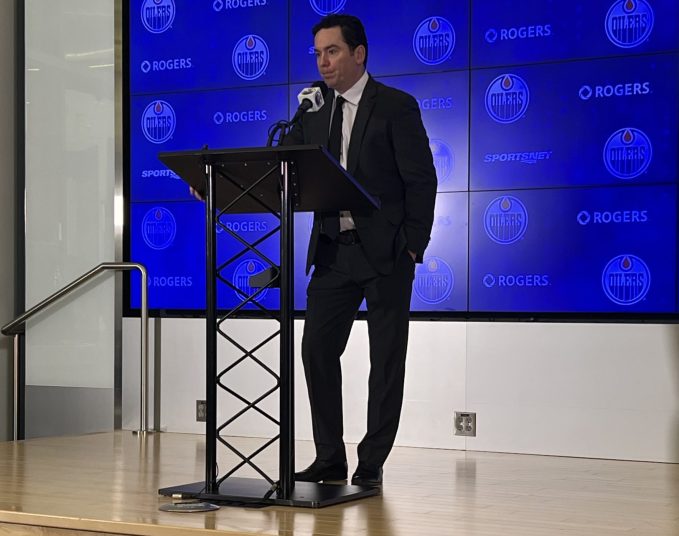Over the course of their five-game win streak, the Oilers have scored 27 times, the kind of offensive output that brings back memories of the 1980s and stand-up goalies who looked like they’re wearing cricket pads.
But it’s not just about the amount of goals — it’s where they are coming from. For a team that’s often maligned for being way too dependent on Connor McDavid and Leon Draisaitl, the winning streak has been all about balanced scoring through the lineup.
Eleven different players – all forwards — have found the net over the past five games. There were blue-paint goals from Derek Ryan, Ryan McLeod and Warren Foegele in Tuesday’s win over Seattle. A big tip-in from Ryan McLeod opened the scoring Thursday against Tampa Bay.
“Secondary scoring, you need it,” said Oilers forward Zach Hyman, who scored a couple in Thursday’s rough-and-tumble 5-3 win over the Tampa Bay Lightning, a team that makes trips to the Stanley Cup seem commonplace. “You don’t need it all the time, but you need guys stepping up and chipping in during key moments of the game, scoring in the dirty areas, the hard areas. Connor got one in the hard area in the last game (the 5-2 win Tuesday over Seattle) and we got three in the paint… I think our group is starting to grow, we’re starting to gain confidence.”
And how much of this has to with coach Jay Woodcroft’s decision to go back to one of his favourite tactics, to dress only 11 forward and swell the defensive ranks to seven skaters?
“It’s a tool in our toolchest,” Woodcroft said after Tuesday’s win over the Seattle Kraken. “For coaches, what you try and do is to eliminate comfort. I don’t think anything good ever comes out of comfort zones. And, sometimes, when you get into that kind of formation, it forces people to raise their game. It forces some forwards to raise their game if they’re taking a little bit extra on that they normally wouldn’t if it was a four-line game. And, for defencemen, when we dress seven D, all of whom can play, it’s a little bit of competition for ice time.”
To the layperson, going with a lineup with seven defenceman and 11 forwards, rather than the traditional six and 12, doesn’t seem like such a big deal. But, four lines of three do not go evenly into 12 — so that means, as the game goes on, linemates get changed. Forwards each get a little more ice time. And defence pairings can change.
It just takes players out of their comfort zone just that little bit. And, for the Oilers, when Woodcroft has utilized it, it has sparked the team. He used it when he first took over as head coach in February of 2022, and the team was in a death-fight for a playoff spot. The Oilers got very high and went from contender to post-season shoo-in. When the Oilers fell behind inthe first round of the playoffs to the Los Angeles Kings, Woodcroft used it in must-win Games 6 and 7. He said that the Oilers best two games against the Colorado Avalanche in the Western Conference final came with the 11-7 look.
Of the major team sports, hockey has always been the least innovative. At least that’s how it looks to casual sports fans.
Football, by its very chess-with-violence nature, is a sport where coaches and coordinators are always looking to create new looks. Baseball got so innovative with the shift that the bosses at Major League Baseball had to ban it. Basketball and soccer offer numerous formations and schemes, and it’s easy to see the Xs and Os as you watch the games.
Hockey, however, has pretty well been three forwards, two defenders and a goalie since the decision was made to ditch the rover from the game. For decades and decades, players “skated their lines.” When Canadians first saw the Soviets play hockey, we were confused. Why were the forwards shifting their positions? Why did they circle in the neutral zone so much? What were these five-man units?
Since then, hockey has seen some innovations, but nothing ever as radical as the other major team sports. And, the funny thing is, lots of fans can talk about things like the neutral zone trap or the left wing lock, but many couldn’t actually describe how they work. Really, when it comes to innovation in hockey, we’re better off talking about advances in the equipment — curved sticks, composite sticks and goalie pads that have expanded in size while becoming lighter and easier to wear.
I’ve had non-hockey fans who, after they’ve been introduced to the game, ask me why teams don’t play with more defencemen and fewer forwards when they’re nursing a lead. Or why some teams don’t radically change the way they set up on the ice. Why is it always wing, centre, wing, two defencemen?
So, excuse me if I get more excited than most about Oilers coach Woodcroft’s continued flirtation with the 11-7 set-up.
Savvy AF. Blunt AF. Edmonton AF.




